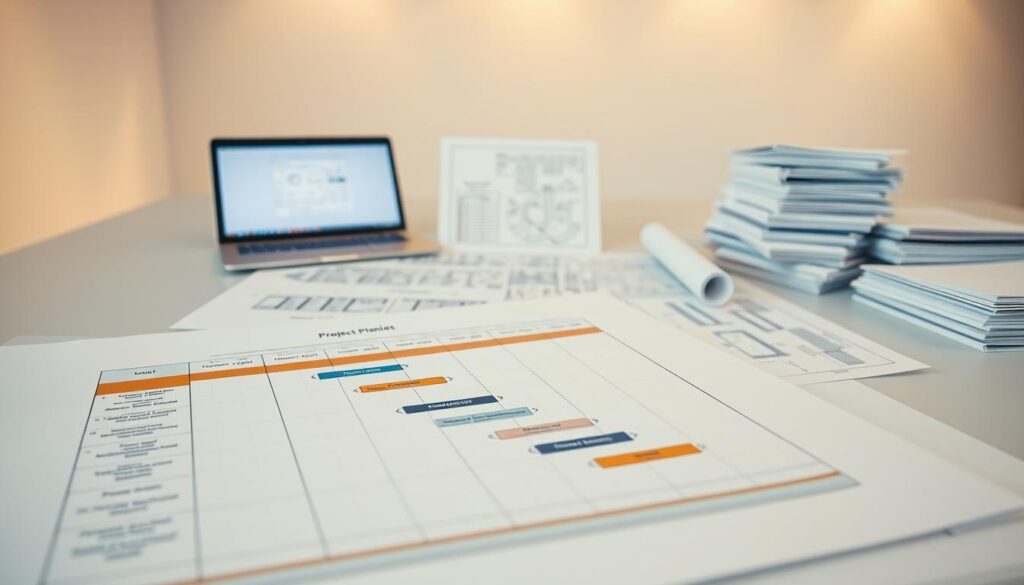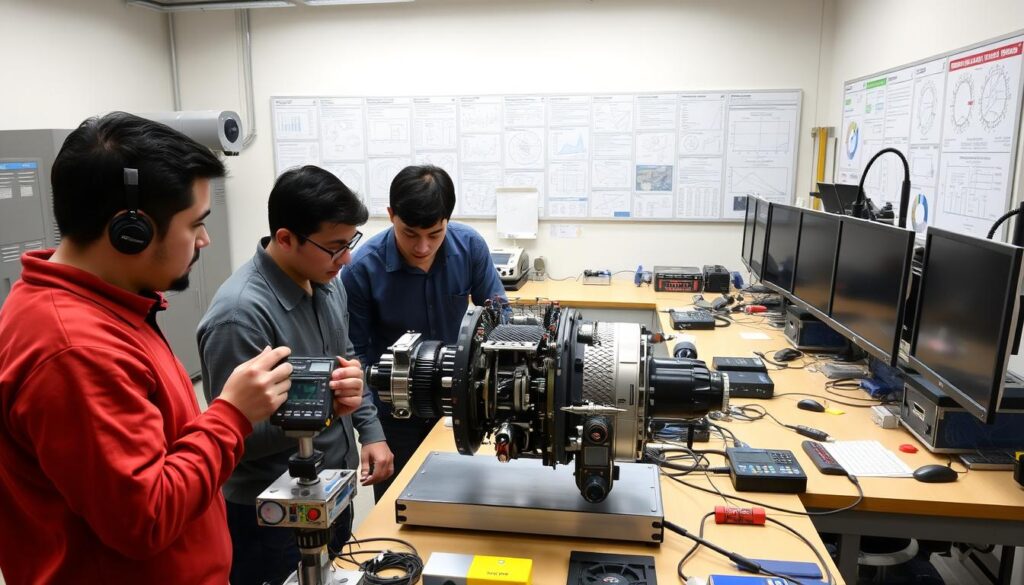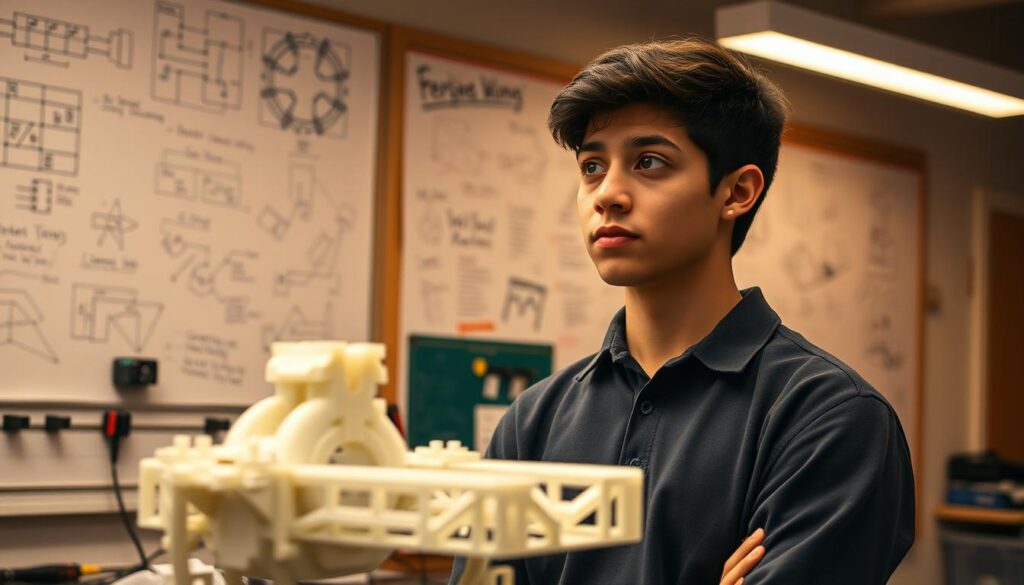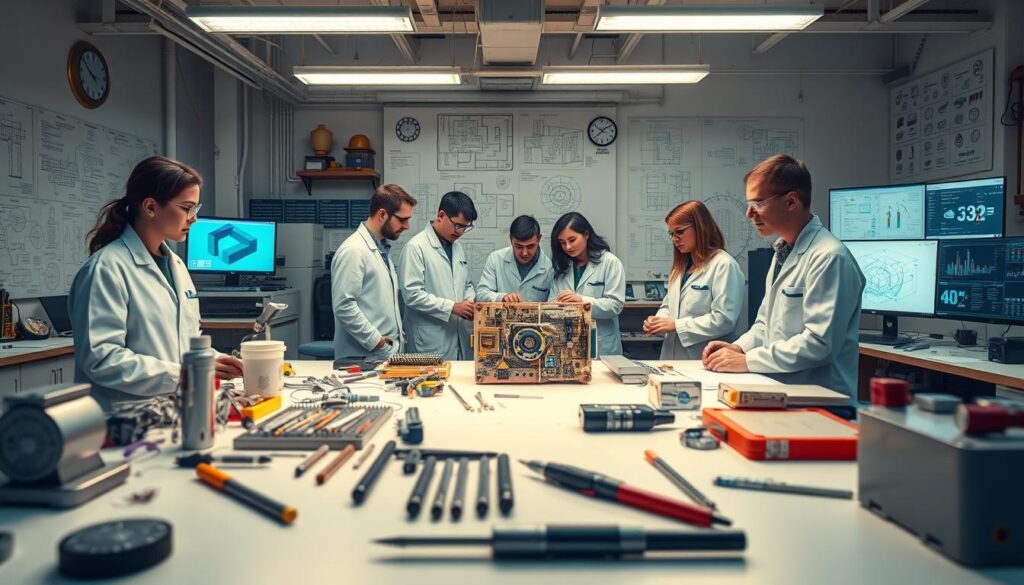Did you know that nearly 75% of engineering students consider their capstone project to be a crucial part of their academic journey, allowing them to apply theoretical knowledge to real-world problems? A capstone project is a significant academic task that requires critical thinking, research, and problem-solving skills. It serves as the final project for many degree programs, enabling students to tackle complex issues like developing a Smart Traffic System for Reducing Urban Congestion.
By following this step-by-step guide, students can ensure that their project is well-planned, executed, and presented. For more detailed information on managing a civil engineering project, additional resources are available.
Key Takeaways
- Understand the requirements of your capstone project.
- Choose a strong, researchable topic relevant to your field.
- Conduct thorough research and gather relevant data.
- Develop a clear thesis statement or research question.
- Create a structured outline for your capstone project.
Understanding the Purpose of a Capstone Project
Understanding the purpose of a capstone project is fundamental to its success in engineering education. An engineering capstone project is designed to be a culminating experience that tests a student’s ability to apply theoretical knowledge to practical problems.
What is an Engineering Capstone Project?
An engineering capstone project is a comprehensive assignment that requires students to demonstrate their skills and knowledge in their chosen engineering discipline. It typically involves designing, analyzing, building, testing, and recommending solutions to real-world problems. This project is often the final year engineering project, showcasing a student’s capabilities before they graduate.
Key characteristics of an engineering capstone project include:
- Application of theoretical knowledge to practical problems
- Integration of multiple engineering disciplines
- Emphasis on design, analysis, and problem-solving
- Development of critical thinking and research skills
Importance in Engineering Education
The capstone project holds significant importance in engineering education as it:
| Aspect | Description |
|---|---|
| Integration of Knowledge | Combines theoretical and practical knowledge |
| Skill Development | Enhances critical thinking, research, and problem-solving skills |
| Real-World Application | Prepares students for real-world engineering challenges |
Goals of a Capstone Project
The primary goals of a capstone project include demonstrating a student’s ability to:
- Design and analyze engineering solutions
- Implement and test their designs
- Recommend improvements based on their findings
By achieving these goals, students showcase their readiness to enter the engineering profession. The capstone project follows an iterative engineering design process, such as Design, Analyze, Build, Test, and Recommend, applying best practices for product design, including understanding customer needs and defining product requirements.
Choosing Your Capstone Project Topic

Choosing the right capstone project is crucial for a successful engineering graduation project. This decision not only impacts your academic experience but also influences your future career prospects. A well-chosen topic can make your project stand out as a significant engineering project showcase.
Brainstorming Ideas
Brainstorming is the first step in selecting a capstone project topic. Start by listing down areas that interest you the most within your field of study. Consider current trends, emerging technologies, and unresolved challenges. Engage in discussions with peers, professors, and industry professionals to gather diverse perspectives.
Effective brainstorming involves exploring various themes and narrowing down your options. You can use techniques like mind mapping or SWOT analysis to organize your thoughts and identify potential project ideas.
Aligning with Your Interests
Aligning your capstone project with your interests is vital for maintaining motivation throughout the project. When you’re passionate about the topic, you’re more likely to produce high-quality work. Reflect on your academic strengths, career aspirations, and personal interests to find a topic that resonates with you.
Consider how your capstone project can contribute to your long-term goals. Whether it’s exploring a specific area of engineering or developing a skill set, ensure that your project aligns with your future plans.
Considering Real-World Applications
A capstone project with real-world applications not only enhances its relevance but also increases its impact. Look for problems or challenges in the industry that you can address through your project. This approach will make your engineering graduation project more meaningful and potentially beneficial to society.
Research existing solutions and identify gaps that your project can fill. This will not only make your project more engaging but also contribute to the field of engineering. By focusing on real-world applications, you can create a project that serves as a compelling engineering project showcase.
Assembling Your Project Team
As you embark on your capstone project, assembling a team that shares your vision and work ethic is vital. A well-functioning team can enhance the overall quality of your project and make the experience more enjoyable.
Finding Team Members
To find the right team members, start by identifying your project’s needs. Consider the skills required for your project, such as technical skills, problem-solving abilities, and communication skills. You can find potential team members through university resources, such as engineering clubs or professional organizations, or by reaching out to classmates and peers.
Tips for finding team members:
- Post about your project on social media or university forums.
- Attend engineering events or seminars.
- Network with peers who share similar interests.
Establishing Roles and Responsibilities
Once you have assembled your team, it’s essential to establish clear roles and responsibilities. This helps prevent confusion and overlapping work, ensuring that each team member knows their tasks and can work efficiently.
Effective role distribution involves:
- Identifying the strengths and weaknesses of each team member.
- Assigning tasks based on individual skills and interests.
- Setting clear expectations and deadlines.
Effective Communication Strategies
Effective communication is the backbone of any successful team. For your capstone project, it’s crucial to establish open and transparent communication channels. Regular team meetings, both in-person and virtual, can help keep everyone on the same page.
Strategies for effective communication:
- Use collaboration tools like Slack or Trello to share updates and files.
- Schedule regular check-ins to discuss progress and challenges.
- Encourage active listening and open feedback among team members.
By following these strategies, you can ensure that your team works cohesively towards a successful capstone project presentation.
Defining Project Objectives and Scope

A well-defined project objective and scope are the cornerstones of a successful engineering capstone project. This step is crucial as it lays the groundwork for the entire project, ensuring that you stay focused and work within the defined boundaries.
Setting Clear Goals
To set clear goals for your engineering capstone project, you need to define what you want to achieve. This involves understanding the needs of your users or customers and aligning your project objectives with these needs. For instance, if you’re working on an innovative engineering project, your goals might include developing a product that is more efficient, cost-effective, or user-friendly.
Consider the following when setting your goals:
- Specificity: Ensure your goals are clearly defined and easy to understand.
- Measurability: Make sure you can measure progress and success.
- Achievability: Set realistic goals that can be achieved within the given timeframe and resources.
- Relevance: Align your goals with the project’s overall purpose and the needs of your stakeholders.
- Time-bound: Establish deadlines for achieving your goals.
Identifying Project Constraints
Every engineering capstone project has constraints that can impact its success. These constraints can be related to time, budget, resources, or technology. Identifying these constraints early on helps you plan accordingly and make necessary adjustments.
| Constraint Type | Description | Example |
|---|---|---|
| Time | Limited timeframe to complete the project | A project that must be completed within a semester |
| Budget | Limited financial resources | A project with a budget of $10,000 |
| Resources | Limited availability of materials, equipment, or personnel | Limited access to specific software or hardware |
Researching Existing Solutions
Researching existing solutions is a critical step in defining your project objectives and scope. It helps you understand what has already been done, what works, and what doesn’t. This knowledge enables you to develop a more effective project plan and avoid potential pitfalls.
When researching existing solutions, consider the following:
- Review existing literature and projects related to your topic.
- Analyze the strengths and weaknesses of existing solutions.
- Identify gaps in current solutions that your project can address.
By following these steps, you can ensure that your engineering capstone project is well-defined, feasible, and has a clear direction, setting you up for success.
Conducting Background Research
The success of a capstone project in engineering heavily relies on the quality of its background research. This foundational step ensures that your project is well-informed, innovative, and addresses real-world needs.
Leveraging Academic Resources
Academic resources are a treasure trove for background research. Journals such as the IEEE Transactions on Engineering and conference papers provide cutting-edge information on the latest developments in your field. To effectively leverage these resources:
- Use academic databases like Google Scholar or IEEE Xplore to find relevant papers.
- Read and analyze the abstracts of papers to determine their relevance to your project.
- Take detailed notes on methodologies, findings, and conclusions.
Using Industry Publications
Industry publications offer insights into current trends, challenges, and innovations. Publications like Engineering.com or industry-specific magazines can provide valuable context for your project. When using these resources:
- Identify publications that are relevant to your project’s focus.
- Look for articles, case studies, or research reports that can inform your project.
- Analyze the information to understand industry needs and potential gaps your project can address.
Engaging with Professionals
Engaging with professionals in your field can validate your research findings and provide practical insights. Attend industry conferences, join professional organizations, or connect with experts on platforms like LinkedIn. When engaging with professionals:
- Prepare thoughtful questions that demonstrate your understanding of the field.
- Listen actively to their experiences and advice.
- Follow up with contacts to continue the conversation and potentially collaborate.
By combining academic rigor with industry insights and professional engagement, you can conduct comprehensive background research that sets your engineering senior design project up for success.
Developing a Project Plan

A well-structured project plan is the backbone of a successful final year engineering project. It serves as a roadmap, guiding you through the various stages of your engineering graduation project and ensuring that you stay on track to meet your objectives.
To develop a comprehensive project plan, you need to break down your project into manageable components. This involves several key steps, starting with outlining the major milestones that mark significant progress in your project.
Outlining Key Milestones
Outlining key milestones is crucial for tracking the progress of your engineering graduation project. These milestones represent significant achievements or decision points in your project. By identifying them, you can create a clear pathway to completing your project. For instance, milestones might include completing the literature review, finalizing your project design, or completing the prototype development.
As emphasized by industry experts, “A well-defined project timeline with clear milestones is essential for the successful execution of complex engineering projects.”
“The key to success lies in the planning. By outlining key milestones, you can ensure that your project stays on track and that you’re making steady progress towards your goals.”
Establishing a Timeline
Once you have identified your key milestones, the next step is to establish a realistic timeline for your project. This involves estimating the time required to complete each task and milestone. It’s essential to be realistic in your estimations to avoid setting unachievable deadlines. For a final year engineering project, time management is critical, and a well-planned timeline helps you allocate sufficient time for each phase of your project.
To create an effective timeline, consider using project management tools like Gantt charts or Kanban boards. These tools can help you visualize your project schedule and make adjustments as needed. For more insights on managing your project timeline, you can refer to resources like this guide on creating a successful product engineering capstone.
Budgeting for Resources
Budgeting is a critical aspect of your project plan, as it determines the resources available for your engineering graduation project. You need to identify the materials, equipment, and personnel required for each stage of your project and allocate a budget accordingly. This involves researching the costs associated with the resources you need and ensuring that you have sufficient funding to complete your project.
Effective budgeting also involves identifying potential cost-saving opportunities and being prepared for unexpected expenses. By managing your budget wisely, you can ensure that your project has the necessary resources to succeed without overspending.
In conclusion, developing a project plan is a foundational step in the success of your final year engineering project or engineering graduation project. By outlining key milestones, establishing a timeline, and budgeting for resources, you can create a comprehensive plan that guides you through the complexities of your project.
Designing Your Engineering Solution
As you embark on designing your engineering solution, collaboration and creativity are key. This phase is where your team’s collective expertise shines, turning innovative ideas into tangible projects that can be showcased in an engineering project showcase.
Collaborating on Design Concepts
Collaboration is at the heart of designing a successful engineering solution. By working together, team members can share diverse perspectives, leading to more robust and innovative designs. Effective collaboration involves:
- Brainstorming sessions to generate a wide range of ideas
- Regular meetings to discuss progress and challenges
- Utilizing collaboration tools to share files and feedback
By fostering an environment where every team member feels valued and heard, you can develop a design concept that truly stands out, potentially becoming one of the best engineering capstone projects.
Prototyping Your Idea
Prototyping is a critical step in the design process, allowing you to test and refine your engineering solution. A well-crafted prototype can help identify potential flaws and areas for improvement early on.
To prototype effectively:
- Start with a simple model to test core functionalities
- Iterate based on feedback and testing results
- Consider using rapid prototyping techniques to save time
Using CAD Software
Computer-Aided Design (CAD) software is an indispensable tool in modern engineering, enabling the creation of precise and detailed models. By using CAD software, you can:
- Create 2D and 3D models of your design
- Simulate various conditions to test your design’s performance
- Make adjustments and improvements before physical prototyping
Mastering CAD software can significantly enhance the quality of your engineering capstone project, making it a standout in any engineering project showcase.
Implementing Your Project

Executing your project plan is a critical step towards delivering a successful engineering project presentation. This phase involves putting your ideas into action, and it’s where your innovative engineering projects start to take shape.
Executing the Plan
The first step in implementing your project is to execute the plan you’ve developed. This involves assigning tasks to team members, setting deadlines, and establishing a system for tracking progress. Ensure that every team member understands their role and responsibilities.
Adapting to Challenges
No project is without its challenges. As you implement your project, you’ll need to be flexible and adapt to any unforeseen issues that arise. This might involve revising your project timeline or adjusting your approach to a particular problem.
Ensuring Quality Control
To deliver a high-quality project, you need to ensure that you’re maintaining rigorous quality control measures. This includes regularly reviewing your progress and making adjustments as needed. Consider implementing a quality control checklist to help you stay on track.
| Quality Control Measure | Description | Frequency |
|---|---|---|
| Progress Review | Review project progress against the plan | Weekly |
| Design Check | Verify that the design meets the project requirements | Bi-Weekly |
| Prototype Testing | Test prototypes to ensure they meet the design specifications | Monthly |
By following these steps and staying focused on your objectives, you’ll be well on your way to delivering a successful engineering project presentation that showcases your innovative engineering projects.
Incorporating Feedback
As you progress with your engineering capstone project, it’s essential to incorporate feedback from various stakeholders to refine your solution. This critical step ensures that your project is well-rounded, effective, and meets the required standards.
Seeking Peer Reviews
One of the most valuable sources of feedback is your peers. They can offer fresh insights and identify potential issues that you might have overlooked. To seek peer reviews effectively, consider the following strategies:
- Share your project progress regularly with your peers.
- Ask specific questions to guide their feedback.
- Be open to constructive criticism and use it to improve your project.
Engaging with Advisors
Your academic advisors can provide guidance based on their experience and knowledge. Engaging with them can help you navigate challenges and ensure that your project is aligned with academic and industry expectations. To engage effectively with your advisors:
- Prepare for meetings by summarizing your progress and outlining your questions.
- Act on the advice given by implementing suggested changes.
- Keep them updated on your project’s progress.
Iterating on Designs
Iterating on your designs based on the feedback received is crucial for enhancing your project’s quality. This process involves refining your ideas, addressing any weaknesses, and ensuring that your solution is robust and effective. For more insights on the engineering design process, you can visit this resource.
By incorporating feedback and iterating on your designs, you can significantly improve the outcome of your engineering capstone project. This not only enhances your project’s quality but also contributes to your growth as an engineer.
Testing and Evaluation

Once your capstone project design is complete, it’s time to validate its effectiveness through comprehensive testing and evaluation. This crucial phase ensures that your final year engineering project meets the desired outcomes and is ready for real-world applications.
Developing Testing Procedures
Developing thorough testing procedures is essential to validate your capstone project in engineering. This involves creating a detailed plan that outlines the tests to be conducted, the parameters to be measured, and the expected outcomes. By doing so, you can systematically assess your project’s performance and identify any potential flaws.
Key considerations when developing testing procedures include:
- Defining clear test objectives
- Selecting appropriate testing methods
- Ensuring safety protocols are in place
Analyzing Results
After conducting the tests, the next step is to analyze the results. This involves comparing the actual outcomes with the expected results, identifying any discrepancies, and understanding the reasons behind them. Effective analysis of results is crucial to determine if your final year engineering project meets the required standards.
The analysis should focus on:
- Performance metrics
- Efficiency and effectiveness
- Potential areas for improvement
Making Improvements
Based on the analysis of the test results, you may need to make improvements to your capstone project. This could involve refining the design, adjusting parameters, or even revisiting the initial concept. The goal is to ensure that your project is robust, reliable, and meets the desired specifications.
Iterative improvements are a key part of the engineering design process. By embracing a cycle of testing, analysis, and refinement, you can significantly enhance the quality and performance of your final year engineering project.
Documenting Your Process
As you near the completion of your capstone project, documenting your process becomes essential for effective communication. This step is crucial in showcasing your hard work and the skills you’ve developed throughout the project.
Writing a Clear Report
A clear and concise report is the backbone of your capstone project’s documentation. It should detail your methodology, findings, and conclusions. According to a study on the value of documentation in the design process, thorough documentation significantly enhances the understanding and appreciation of the project’s complexities (source).
To achieve clarity, focus on structuring your report logically, using headings and subheadings to guide the reader. Ensure that your writing is free of jargon and technical terms are explained.
Including Visual Aids
Visual aids such as diagrams, charts, and graphs can significantly enhance the clarity and impact of your report. For instance, using CAD software can help create precise drawings that illustrate your engineering solution (source). When incorporating visual aids, ensure they are clearly labeled and referenced in the text.
| Type of Visual Aid | Purpose | Example |
|---|---|---|
| Diagrams | Illustrate complex systems | Circuit diagrams |
| Charts | Display data trends | Bar charts, Pie charts |
| Graphs | Show relationships between variables | Line graphs, Scatter plots |
Preparing for Presentations
Preparing for presentations is an integral part of showcasing your engineering graduation project. Your presentation should succinctly convey the essence of your project, highlighting its significance and your achievements. Practice your delivery to ensure you stay within the allotted time and can address questions confidently.
By focusing on these aspects, you’ll be well-prepared to present your capstone project effectively, making a strong impression on your audience.
Preparing for Capstone Presentations

Preparing for your capstone presentation is an essential step that showcases your project’s achievements. A well-structured presentation not only highlights your project’s key findings but also demonstrates your ability to communicate complex ideas effectively.
Structuring Your Presentation
A clear and logical structure is vital for a successful presentation. Begin by outlining the key elements you want to cover, such as the problem statement, your approach, and the outcomes. Use visual aids like slides, diagrams, and charts to support your narrative and keep your audience engaged.
- Introduction: Introduce your project and its significance.
- Methodology: Explain your approach and the techniques used.
- Results: Present your findings and outcomes.
- Conclusion: Summarize your project’s achievements and implications.
Tips for Effective Public Speaking
Effective public speaking is crucial for delivering a compelling presentation. Practice your delivery to ensure you speak confidently and clearly. Rehearse in front of peers or mentors to get feedback on your presentation style and content.
“The art of communication is the language of leadership.” – James Humes
Some additional tips include:
- Maintain eye contact with your audience.
- Use a clear and steady voice.
- Be prepared to answer questions.
Anticipating Questions
Anticipating potential questions from your audience can help you prepare thoughtful responses. Consider the strengths and weaknesses of your project and be ready to discuss them. Common questions might relate to your methodology, results, or the broader implications of your project.
By structuring your presentation clearly, practicing effective public speaking, and anticipating questions, you can confidently showcase your capstone project and make a lasting impression on your audience.
Showcasing Your Capstone Project
Your innovative engineering project deserves to be showcased to inspire and inform others. Showcasing your capstone project is a crucial step in your engineering education journey, allowing you to demonstrate your skills and achievements to a wider audience.
Organizing a Presentation Event
Organizing a presentation event is an effective way to share your engineering capstone project with peers, faculty, and industry professionals. Start by selecting a suitable venue that can accommodate your audience and project display. Ensure that the venue is equipped with necessary audiovisual equipment to support your presentation.
Promote your event through various channels such as social media, email invitations, and posters on campus. Consider inviting industry experts and potential employers to provide valuable feedback and potential job opportunities. For more insights on capstone projects, you can visit resources like https://capstone.cec.fiu.edu/ to learn from successful projects.
Creating a Final Project Display
A well-designed final project display is essential for effectively communicating your project’s outcomes. Use clear and concise language on posters and displays to highlight your project’s key features and achievements. Incorporate visual aids such as diagrams, charts, and images to make your display engaging.
Ensure that your display is professionally presented, as it reflects your attention to detail and professionalism. Consider the layout and flow of information to keep your audience engaged.
Sharing Your Work Online
In today’s digital age, sharing your work online can significantly amplify your reach. Create a digital portfolio or a website dedicated to your engineering capstone project. Utilize social media platforms and professional networks like LinkedIn to share your project’s progress and outcomes.
Consider creating a video or a written blog post about your project to share on platforms like YouTube or Medium. This not only showcases your project but also demonstrates your ability to communicate complex ideas to a broader audience.
Reflecting on the Experience

As you complete your engineering senior design project, it’s essential to reflect on the journey and the valuable lessons learned along the way. This reflection is a crucial step in appreciating the knowledge and skills gained during your capstone project in engineering.
Lessons Learned
One of the most significant aspects of reflecting on your capstone experience is identifying the lessons learned. These can range from technical skills acquired during the project to soft skills like teamwork and time management. For instance, you might have learned how to effectively collaborate with team members, prioritize tasks, or manage project timelines. According to a guide on capstone projects, such experiences are invaluable in shaping your approach to future engineering challenges (CP-FG-11.pdf).
“The capstone project is a culmination of the knowledge and skills gained throughout your engineering program,” says an expert in engineering education. “It’s a chance to apply theoretical knowledge to real-world problems, and in doing so, you learn a great deal about your capabilities and areas for improvement.”
Personal Development Insights
Reflecting on your capstone project also provides insights into your personal development. You may discover strengths you weren’t aware of, such as leadership skills or problem-solving abilities. Conversely, you might identify areas where you need further development, like public speaking or project management. Recognizing these aspects can guide your personal and professional growth.
- Enhanced problem-solving skills through hands-on experience
- Improved communication skills, both written and verbal
- Better time management and organizational skills
Future Implications in Your Career
The experience and skills gained from your capstone project have significant implications for your future career. Employers often look for evidence of practical experience and problem-solving skills, both of which are showcased through a well-executed capstone project. By reflecting on your experience, you can articulate these skills to potential employers, enhancing your job prospects.
Key takeaways from your reflection should include the skills you’ve developed, the challenges you’ve overcome, and how these experiences will shape your future career decisions. This reflection not only boosts your confidence but also prepares you for the next steps in your professional journey.
Preparing for Your Professional Journey
As you near the completion of your capstone project, a crucial milestone in your final year engineering project, it’s essential to leverage your achievements to propel your career forward. Your engineering graduation project is a testament to your skills and knowledge, making it a valuable asset in job applications.
Showcasing Your Skills
Highlighting your capstone project in job applications can significantly enhance your prospects. It demonstrates your ability to tackle complex problems, work collaboratively, and apply theoretical knowledge to real-world scenarios. For more insights on crafting a successful capstone project, you can refer to resources like Crafting a Successful Capstone Project.
Networking and Continuing Education
Exploring networking opportunities can help you establish valuable connections in your field. Consider attending industry events, joining professional organizations, or connecting with experienced professionals on platforms like LinkedIn. For fresh graduates, understanding the job opportunities available in the civil engineering sector can be beneficial, as outlined in resources like Civil Engineering Job Opportunities for Fresh. Continuing education options, such as certifications or advanced degrees, can further develop your knowledge and skills, making you a more competitive candidate in the job market.
